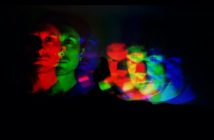“If there’ stuff that I’m listening to – for example the last couple of years I’ve just really liked dance music or dub – where it’s really sculptural, I want to pilfer those ideas for Holy Balm specifically. I’m always trying to replicate the elements of that music that I think would suit Holy Balm, or the scenario of Holy Balm.”
Says Emma Ramsay, one third of psychedelic dance jam Holy Balm, with more self-reflection than you’d find in even the most established band. It’s a few weeks on from a mind blowing performance at Newcastle’ This Is Not Art festival and Emma sits humbly on the couch in the house her band mates Jonathan Hochman and Anna John both inhabit. Jonathan (Yoni to mates) joins her on the couch while Anna is holed up someplace working on her honours project.
Both Emma and Yoni seem oblivious to the superlatives floating around the Internet in reference to their band. “HOLY BALM – The best band in the whole World?” is the title of a thread on one Australian music message board. After said mind blowing performance in Newcastle I’m inclined to ask the same question.
Having started making music together in early 2006 when all members were sharing a house in the Sydney suburb of Newtown, Holy Balm have a sound that has evolved or, rather, revolved over the last four years.
“Constantly building on wherever we’re at” is how Emma describes it. Yoni agrees; ” I feel like we kind of do a version of what we did at our first show – we still kind of play that exact same thing now. It’s sort of different; it’s slightly different but still the same set of notes, the same sort of tempo. Like some things come and go but it’s still the same.”
“Like ditties. Like a collection of ditties,” Emma offers.
Ditties built around the rhythms of a drum machine, the sonic embellishments of Emma’ percussion and – for want of a better term – “lead†guitar, as well as the textured ditties/ droned melodies that come through the alternate channels of Yoni and Anna’ synths. The result is something difficult to describe without the words pysch/noise/jam/dance being morphed into an awkward neologism. Other attempts have included noise dance punk, blown out funk, slop rave or “indie kids who just discovered house music.†None of these are accurate in terms of sound, nor exhaustive of influence.
Yoni: “I think in a way the biggest influence is just actually playing – If I can think of a way to get two drum machines to synchronise together and play a certain kind of rhythm that I might like then that’s as big an influence as anything I might hear on a record… and maybe the biggest influence is whoever designed my synthesizer, or, like, technology? These sounds that you can get from your instrument, that’s a big part of what it is. So what do you say? Do you say Robert Moog is a big influence?”
Emma: “Or maybe that also translated in the way that artists that you like all have a similar relationship to sound, across styles and genres. Like lots of really great disco, really vintage disco that has a really amazing relationship with – like it keeps people on the dancefloor, and there can still be really jarring things happening there even though it’s still disco. That’s interesting, and a big influence, because you can see that you can do all these things, you can have something really abstract come in on the vocal, but only for two bars, it doesn’ have to be trashy. Or like dubstep or something, where it’s really sculptural and there’ so much sound, that’s kind of an influence. Not necessarily a certain song or something.”
Yoni: “I’m always thinking about the sounds of my instrument, and the way that the synthesizer works, and the sounds I can get from the synthesizer and the kinds of things you can do with a drum machine. It’s interesting what you can do with just a simple thing like changing the tone or the depth of a drum sound, how things can build in a trance-like way, in a repetitive way, rather than something that’s so heavily structured. I think we’re all really interested in that manipulation, and that kind of tonal stuff.”
The approach that Holy Balm takes to music making is, in many ways, their strongest defining feature. All three members have energies going into other projects – Anna is one half of trippy guitar duo Knitted Abyss, Yoni makes music in Hochman & Hopkins and as Pagan Dawn and Emma has recently started working on sound-based projects and a solo project that magically weaves voice, fortune telling and more – and in many ways it is because of these alternate projects that Holy Balm is such a distinct being. While Emma’ focus is on the way that dance music can be sculpted into sound, Yoni is very much about the sound. It’s that attention to tone and that intent in rhythm that defines Holy Balm, setting them apart from both contemporaries and classics. The interaction perfectly sums up Holy Balm.
Adamant that they’re not an improv group, Holy Balm create a frame of reference that facilitates a loose and open ended performance. One of the most important elements of that frame of reference is the stuff that happens outside of Holy Balm, essentially a group of friends that dates back to before their initial jams together.
In recalling their gestation period Emma remembers how she and Anna approached Yoni about being a band; “I think Yoni had records set up and was always playing records and I think we wanted to be a kind of record club too.” That element still stands strong with Holy Balm, especially at a time where they’ve been playing ‘venue to venue’ with no time for rehearsals, and where the group develops musically through building upon the last show rather than prescribing a direction to head in.
“I think we know how to support each other musically,” Yoni says with an air of certainty.
Emma continues; “I think it’s something that… Having the textures down pat, like having a trick bag of textures and tones and little rhythms, and I think we’re just constructing from that – loosely knowing and coming out of that.”
Within days of forming, the three-piece were invited to perform at the very first Chooch-A-Bahn, a now defunct collective that revived and reshaped DIY culture in music from Sydney and beyond. Through parties curated around ethos rather than a particular aesthetic, style or genre Chooch-A-Bahn gave a name, a place and a home to exist outside of a stifled Sydney venue circuit.
“It wasn’t something you do because you couldn’t get a show at the traditional venues, it was actually an appealing preference,” Yoni says.
In many ways Holy Balm exemplify what Chooch-A-Bahn was – a parallel universe that was rethinking, reworking and reimagining standards. The standard reimagined with Holy Balm is dance music.
“We can all be quite tonal and minimal and there’ still something to dance to,” Yoni says. “I think about the idea of playing at two or three in the morning so people actually want to dance – that other scenario of the night club.” Both Yoni and Emma reference New York disco and Krautrock as influences, pointing to their own music as another example of long form dance. I particularly revel in Yoni’ suggestion of an “endless dancefloor.”
Having released only a split CDR (with Sydney’ Vincent over the Sink) and a split cassette (with Melbourne’ Bum Creek, available through Spanish Magic), Holy Balm are predominantly a live band. How come?
One reading is they haven’ gotten around to recording something more. This is, in part, true, but I prefer to take an alternate reading: the endless dancefloor. Or, more precisely, the conversation that Holy Balm builds with their audience and the positioning of that conversation as being as important and influential as anything else they’d cite.
“When people start reacting to things you can really tell, you get an instant reaction to what you’re doing and it’s interesting how much people actually respond to really minor tonal changes,” Yoni offers.
Emma continues; “Exploring all the things – how to get that instant reaction, is kind of like – exploring that in a studio is fine in the sense that you get gratification in the final product, but you still really enjoy getting that live reaction and performing and doing it live because there’ all these elements of chance and potential for mistake and failure, which I think is actually a really big part of how we move into different territories anyway, just when we’re playing together. The certain directions that we’ve gone [have happened]through certain things going wrong live, through actually experimenting.”
“You learn a lot that way,” Yoni agrees. “I think a really big part of it is that it is the three of us, and we’re in a space together, and we’re playing and feeding off each other. It’s not necessarily improvised – I wouldn’ say that – but that does come into it and I think we play things differently every time, and I think that’s got a lot to do with a mood or a space.”
And I’m back to wanting to call Holy Balm situationists, ignoring any historical inaccuracy. Yoni and Emma both put forward the abovementioned show in Newcastle as the best example of how a scenario can feed into a sound. A show where Melbourne vocal artists Gugg, the hugely transcendental Bum Creek and visual comedian/renowned faliare [sic]embracer John Kilduff joined Holy Balm on stage for the closest thing to religion I’ve experienced since Catholic schoolgirl days.
“We didn’ plan that,” Emma says, with smiling bewilderment.
Yoni agrees. “That could never happen if you just worked in the studio behind closed doors. Some of my instruments actually failed to work and we couldn’ do a set that we would have normally done, and that sort of tends to happen – something might not work or you might not like the sound of something or you might get onto a particular sort of rhythm or note or whatever that you kind of want to keep going with.”
“It’s almost like a scenario based band, and it’s kind of like all these different elements coming in to play, like when we play live the other bands that we’ve played with on that bill, how far we’ve tested the idea or we’ve just tried something incredibly new that day, these are all these things that contribute – just like anyone else playing live, I guess, but we’re also really happy for there to be a lot of room for things to spill out.”
Spilling out all over the place, tonaldronepsychbeatjam never sounded quite as good until Holy Balm existed.
Holy Balm’s split cassette with Bum Creek is now available through Spanish Magic.


